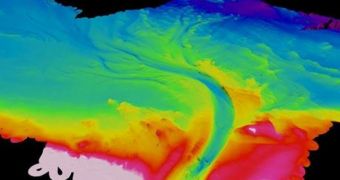Scientists have just discovered the sixth largest river in the world. Unfortunately, the landscape feature cannot claim its rightful title because it's not located on land. Researchers conducting a series of investigation on the bottom of the Black Sea, in eastern Europe, discovered the water course submerged below the surface of the water. The river is as much as 115 feet (35 meters) deep in some places, and it has already carved up channels and other features characteristics to water flows.
The investigations team says that the water currents they discovered are about 350 times greater than the River Thames, which flows at the heart of London, England. It was also discovered that the underwater river features elements such as rapids and waterfalls, which is something extremely unusual given the circumstances. The new study has tremendously important implications for explaining how marine life manages to survive in the deep sea, far away from shorelines.
Generally, marine life abounds near land because rivers tend to bring with them nutrients and sediment from inland. Many creatures feed on these chemicals, and so it stands to reason that the trophic chain is extremely well developed at these locations. But underwater rivers may contribute to carrying nutrients to the deep and open ocean as well, allowing for life to exist in areas that could otherwise be considered as inhospitable for complex organisms. The new work was carried out by experts at the University of Leeds, who used a robotic submarine to scan the bottom of the Black Sea.
“The water in the channels is denser than the surrounding seawater because it has higher salinity and is carrying so much sediment. It flows down the sea shelf and out into the abyssal plain much like a river on land. The abyssal plains of our oceans are like the deserts of the marine world, but these channels can deliver nutrients and ingredients needed for life out over these deserts. This means they could be vitally important, like arteries providing life to the deep ocean. The key difference we found from terrestrial rivers was that as the flow goes round the bend, the water spirals in the opposite way to rivers on land,” says Leeds School of Earth and Environment expert, Dr Dan Parsons.
“This is the first time we have been able to show that there is a flow through a natural channel system and take direct measurements of what the flow is like and how that is linked to the shape and morphology of the channel,” he concludes, quoted by The Telegraph.

 14 DAY TRIAL //
14 DAY TRIAL //